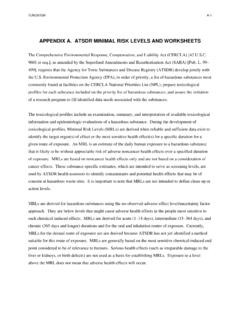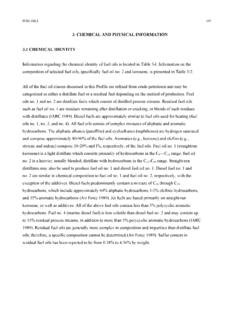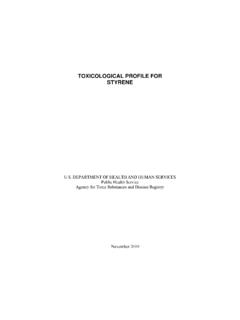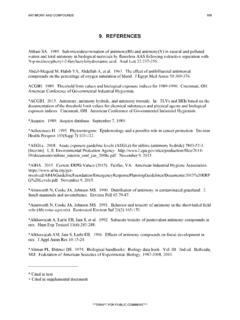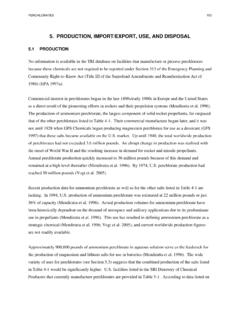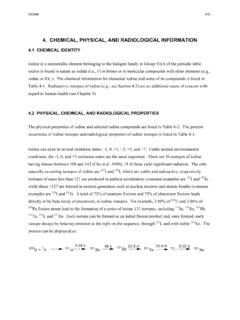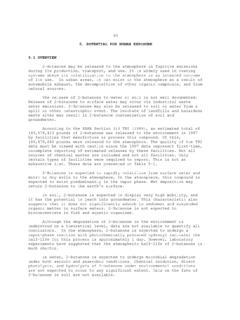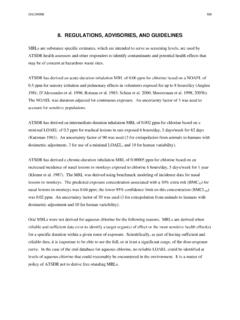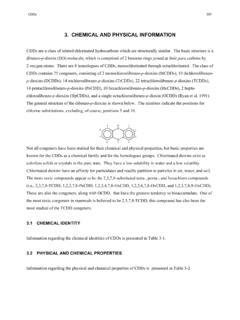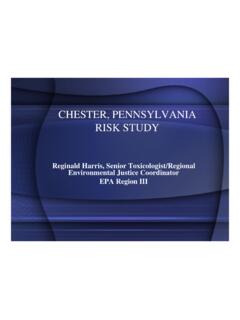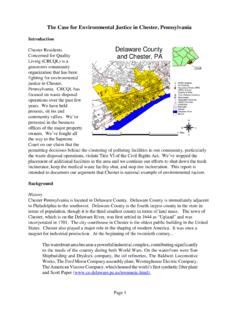Transcription of APPENDIX A. ATSDR MINIMAL RISK LEVELS AND …
1 A-1 TOLUENE DIISOCYANATE AND METHYLENEDIPHENYL DIISOCYANATE APPENDIX A. ATSDR MINIMAL RISK LEVELS AND WORKSHEETS The Comprehensive environmental Response, Compensation, and Liability Act (CERCLA) [42 9601 et seq.], as amended by the Superfund Amendments and Reauthorization Act (SARA) [Pub. L. 99 499], requires that the Agency for Toxic Substances and Disease Registry ( ATSDR ) develop jointly with the environmental Protection Agency (EPA), in order of priority, a list of hazardous substances most commonly found at facilities on the CERCLA National Priorities List (NPL); prepare toxicological profiles for each substance included on the priority list of hazardous substances; and assure the initiation of a research program to fill identified data needs associated with the substances.
2 The toxicological profiles include an examination, summary, and interpretation of available toxicological information and epidemiologic evaluations of a hazardous substance. During the development of toxicological profiles, MINIMAL Risk LEVELS (MRLs) are derived when reliable and sufficient data exist to identify the target organ(s) of effect or the most sensitive health effect(s) for a specific duration for a given route of exposure. An MRL is an estimate of the daily human exposure to a hazardous substance that is likely to be without appreciable risk of adverse noncancer health effects over a specified route and duration of exposure. MRLs are based on noncancer health effects only and are not based on a consideration of cancer effects. These substance-specific estimates, which are intended to serve as screening LEVELS , are used by ATSDR health assessors to identify contaminants and potential health effects that may be of concern at hazardous waste sites.
3 It is important to note that MRLs are not intended to define clean-up or action LEVELS . MRLs are derived for hazardous substances using the no-observed-adverse-effect level/uncertainty factor approach. They are below LEVELS that might cause adverse health effects in the people most sensitive to such chemical-induced effects. MRLs are derived for acute (1 14 days), intermediate (15 364 days), and chronic (365 days and longer) durations and for the oral and inhalation routes of exposure. Currently, MRLs for the dermal route of exposure are not derived because ATSDR has not yet identified a method suitable for this route of exposure. MRLs are generally based on the most sensitive substance-induced endpoint considered to be of relevance to humans. Serious health effects (such as irreparable damage to the liver or kidneys, or birth defects) are not used as a basis for establishing MRLs.
4 Exposure to a level above the MRL does not mean that adverse health effects will occur. MRLs are intended only to serve as a screening tool to help public health professionals decide where to look more closely. They may also be viewed as a mechanism to identify those hazardous waste sites that A-2 TOLUENE DIISOCYANATE AND METHYLENEDIPHENYL DIISOCYANATE APPENDIX A are not expected to cause adverse health effects. Most MRLs contain a degree of uncertainty because of the lack of precise toxicological information on the people who might be most sensitive ( , infants, elderly, nutritionally or immunologically compromised) to the effects of hazardous substances. ATSDR uses a conservative ( , protective) approach to address this uncertainty consistent with the public health principle of prevention.
5 Although human data are preferred, MRLs often must be based on animal studies because relevant human studies are lacking. In the absence of evidence to the contrary, ATSDR assumes that humans are more sensitive to the effects of hazardous substance than animals and that certain persons may be particularly sensitive. Thus, the resulting MRL may be as much as 100-fold below LEVELS that have been shown to be nontoxic in laboratory animals. Proposed MRLs undergo a rigorous review process: Health Effects/MRL Workgroup reviews within the Division of Toxicology and Human Health Sciences, expert panel peer reviews, and agency-wide MRL Workgroup reviews, with participation from other federal agencies and comments from the public. They are subject to change as new information becomes available concomitant with updating the toxicological profiles. Thus, MRLs in the most recent toxicological profiles supersede previously published LEVELS .
6 For additional information regarding MRLs, please contact the Division of Toxicology and Human Health Sciences, Agency for Toxic Substances and Disease Registry, 1600 Clifton Road NE, Mailstop F-57, Atlanta, Georgia 30329-4027. A-3 TOLUENE DIISOCYANATE AND METHYLENEDIPHENYL DIISOCYANATE APPENDIX A MINIMAL RISK LEVEL (MRL) worksheet Chemical Name: Toluene diisocyanate CAS Number: 26471-62-5 Date: June 2018 Profile Status: Final Route: [X] Inhalation [ ] Oral Duration: [X] Acute [ ] Intermediate [ ] Chronic Graph Key: 1 Species: Humans MINIMAL Risk Level: 1x10-5 [ ] mg/kg/day [X] ppm Reference: Vandenplas O, Delwiche J-P, Staquet P, et al. 1999. Pulmonary effects of short-term exposure to low LEVELS of toluene diisocyanate in asymptomatic subjects.
7 Eur Respir J 13:1144-1150. Experimental design: In this single-blind crossover design study, 17 volunteers (8 male, 9 females) were exposed to ambient air or ppm TDI for 6 hours followed by a 20-minute exposure to ppm TDI. Pulmonary function testing was conducted prior to exposure and every hour during the 6-hour exposure and at the end of the 20-minute exposure to ppm or air. Bronchial lavage (BL) and bronchoalveolar lavage (BAL) were performed 1 hour after the end of the exposure. Effect noted in study and corresponding doses: None of the subjects reported respiratory symptoms in response to the exposure. TDI exposure was associated with a slight, but significant, decrease in specific airway conductance (sGaw) and maximal expiratory flow at 25% of forced vital capacity (MEF25%). No significant alterations in the volume of fluid recovered or total and differential cell counts were observed in the BL and BAL after TDI exposure, as compared to air exposure.
8 Exposure to TDI was associated with a decrease in the proportion of CD19 cells in the BL and BAL, although there was no difference in the absolute number of cells. A slight but statistically significant increase in BAL albumin LEVELS and BL -2-macroglobulin LEVELS were observed. Dose and end point used for MRL derivation: LOAEL of ppm for decreased lung function [ ] NOAEL [X ] LOAEL Uncertainty Factors used in MRL derivation: [X] 10 for use of a LOAEL [ ] 10 for extrapolation from animals to humans [X] 10 for human variability Was a conversion factor used from ppm in food or water to a mg/body weight dose? Not applicable. If an inhalation study in animals, list conversion factors used in determining human equivalent dose: Not applicable. Was a conversion used from intermittent to continuous exposure? Yes. The LOAEL of ppm was adjusted for intermittent exposure: ppm x 6 hours/24 hours = ppm A-4 TOLUENE DIISOCYANATE AND METHYLENEDIPHENYL DIISOCYANATE APPENDIX A Other additional studies or pertinent information that lend support to this MRL: In another acute-duration human study, no alterations in specific air way resistance were observed in healthy or asthmatic subjects exposed to ppm TDI for 20 minutes (Chester et al.)
9 1979). Acute-duration animal inhalation studies have reported rhinitis, lung damage, and airway hyperresponsiveness. The severity of rhinitis was concentration-related; moderate rhinitis was observed in mice exposed to ppm 6 hours/day for 4 days (Zissu 1995), moderate-to-severe rhinitis was observed in mice exposed to ppm 6 hours/day for 5 days (Buckley et al. 1984), and severe nasal lesions were observed in mice exposed to 1 ppm 6 hours/day for 3 days (Arts et al. 2008). Interstitial inflammation, pleural thickening, and goblet cell hyperplasia were observed in the lungs of guinea pigs exposed to ppm TDI 3 hours/day for 3 days (Wong et al. 1985). Airway hyperresponsiveness to methacholine or acetylcholine was also observed in guinea pigs and mice exposed to ppm (Gagnaire et al. 1996; Gordon et al. 1985; Marek et al. 1999); a NOAEL of ppm for airway hyperresponsiveness was identified in guinea pigs exposed to TDI 6 hours/day for 5 days (Marek et al.
10 1999). An increase in the incidence of litters with poorly ossified cervical centrum was observed in the offspring of rats exposed to ppm commercial-grade TDI 6 hours/day on GDs 6 15 (Tyl et al. 1999a); this concentration was also associated with maternal toxicity including a marked decrease in body weight gain and signs of nasal irritation and audible respiration. Support for basing the MRL on a single exposure study comes from chronic occupational exposure studies. The lowest LOAEL values identified in longitudinal studies of workers exposed to TDI were and ppm (Clark et al. 1998; Diem et al. 1982); the effects observed at these concentrations included decreases in lung function (FEV1 and/or FVC). These LOAELs are roughly 2 4 times lower than the LOAEL from the Vandenplas et al. (1999) study. However, since there is uncertainty that the MRL would be protective for continuous exposure for 14 days, it is suggested that measured air concentrations should not exceed the MRL of 1x10-5 ppm during a 24-hour period.
